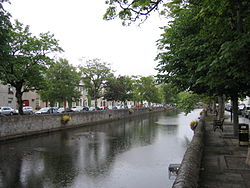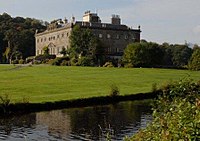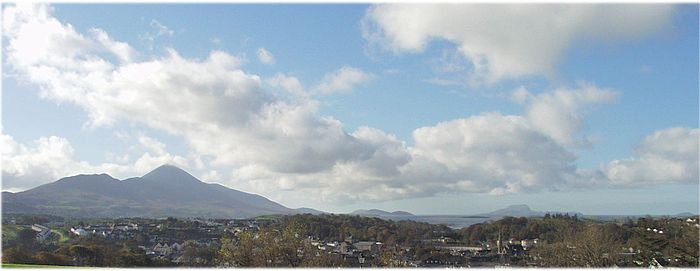Westport, County Mayo
| Westport Irish: Cathair na Mart | |
| County Mayo | |
|---|---|
 Mall along Carrowbeg River in Westport | |
| Location | |
| Grid reference: | M004841 |
| Location: | 53°48’-0"N, 9°31’60"W |
| Data | |
| Population: | 5,543 (2011) |
| Local Government | |
| Website: | westporttc.ie |
Westport is a town in County Mayo, at the south-east corner of Clew Bay, an inlet of the Atlantic coast of Ireland.
The town is known in the Irish language as Cathair na Mart, which means "Stone fort of the beef cattle" or possibly "City of the fairs". Historically the town was named by an Anglicisation of this name: Cahernamart[1]
Westport was the home of the pirate chief Grace O'Malley in the mid-to-late 16th century.
Contents
About the town
The town centre was designed by James Wyatt in 1780, in the Georgian architectural style. Its layout follows the mediæval principles of urban design introduced by the Normans in the 13th century. The design for the town was commissioned by the Marquess of Sligo of the nearby stately home, Westport House, as a place for his workers and tenants to live. A particular feature is the incorporation of the river into the composition, contained for two blocks by low stone walls producing, on each side of the river, attractive tree lined promenades (The Mall) with several stone bridges over the River Carrowbeg. The layout further includes several tree-lined streets, addressed by the narrow fronted commercial buildings typical of Irish towns, though with many here remaining of a singular refinement and charm. Some modern interventions, such as the Garda station, are less successful in maintaining the original continuity of the urban fabric.
The famous pilgrimage mountain of Croagh Patrick, known locally as "the Reek", lies some seven miles west of the town near the villages of Murrisk and Lecanvey. The mountain offers a striking backdrop to the town. The church on the summit can just be made out with the naked eye from Westport.
Westport is a popular tourist destination and scores highly for Quality of Life.[2] It has also won the Irish Tidy Towns Competition three times in 2001, 2006 and 2008; in 2012 it also won the Best Place to Live in Ireland competition run by The Irish Times.
History
A 16th-century castle stands here, which gives the town its Irish name Cathair na Mart (meaning Stone Fort of the Beeves, a stronghold belonging to the powerful local seafaring Ó Máille Clan, who controlled the Clew Bay area, then known as Umaill.
The original village of Cathair na Mart existed somewhere around what is now the front (East) lawn of Westport House. It had a high street, alleys down to the river and a population of around 700.[3] It was moved to its present site in the 1780s by the Browne family of Westport House, who also renamed it Westport.
Westport is designated as a heritage town and is one of only a few planned towns in the country.[4] The design of the town is attributed to James Wyatt, who also completed Westport House, the stately home of the Marquess of Sligo and designed its dining room. Westport House had originally been built by Richard Cassels, the German architect, in the 1730s, on the site of the original Ó Máille Castle. The dungeons of the Ó Máille castle still remain. The most notable feature of James Wyatt's town plan is the tree-lined boulevard, the Mall, built on the Carrowbeg River.
Since the late 20th century, Westport has greatly expanded with several new estates. Some of the most populous estates are: Springfield, the Carrowbeg Estate, Horkans Hill, Cedar Park, Fairways, Knockranny Village and Sharkey Hill.
Westport House
Designed by the famous architects Richard Cassels and James Wyatt in the 18th century, Westport House is considered one of the most significant historic homes open to the public. Westport House is situated in a parkland setting with a lake, terraces, gardens and views overlooking Clew Bay, the Atlantic Ocean, Achill, Clare Island and Ireland's Holy Mountain, Croagh Patrick. It was built and is still privately owned by the Browne family, who are direct descendants of the 16th-century pirate, Grace O'Malley (Gráinne Ní Mháille), Queen of Umaill.
Gráinne Ní Mháille was a leading Gaelic-Irish chief in Connaught in the sixteenth century, and after her death, a report by Sir Richard Bingham, Governor of Connaught, stated that for forty years she was the stay of all rebellions in the West.[5] She was chief of the O'Malley Clan and ruled the seas around Mayo. Ní Mháille had several castles in the west of Ireland and it was on the foundations of one of these that Westport House was built. There is still an area of her original castle in the basement of the House (the Dungeons), which is on view to visitors.
There is a bronze statue of Ní Mháille by the artist Michael Cooper situated on the grounds of Westport House.
The original House was built by Colonel John Browne, a Jacobite, who was at the Siege of Limerick, and his wife Maude Bourke. Maude Bourke was Ní Mháille’s great-great granddaughter (reported by Anne Chambers to greatly resemble her). The House then did not have the lake or a dam and the tide rose and fell against the walls.[6]
Churches
There are three churches in the town:
- Church of Ireland: Holy Trinity
- Roman Catholic: St Mary's
- Evangelical: Calvary Church Westport.
Historically, a Methodist church stood on the Mall. It is currently a restaurant.
Church records for the 19th century for the Westport area (Church of Ireland, Methodist, Roman Catholic, civil, gravestone inscriptions, etc.) and other historical records are held at the South Mayo Family Research Centre in Ballinrobe and The Clew Bay Heritage Centre at Westport Quay.
The Quay
Westport has a small adjoining port, the Quay, once busy but no longer used for commercial shipping, now a suburb notable for its many warehouse conversions.The quay is also known for its restaurants and pubs. It also includes the famous "point" pitch, training ground of Westport United. * A small museum, celebrating the history of Westport and maritime history of Clew Bay, is open to the public here, the Clew Bay Heritage Centre.
In 1894, the harbour was the scene of a famed tragedy, the Clew Bay Drowning.
Culture
People from Westport town are traditionally known as Coveys. Some decades ago the Covey dialect still existed and was unintelligible to outsiders. For example, the Covey word for a woman was a "doner". To this day inhabitants of nearby areas, including Castlebar, refer to the people of Westport, sometimes mildly disparagingly, sometimes somewhat affectionately, as Covies.
Matt Molloy of the Chieftains has a musical pub on Bridge Street.
Westport through the year
Many festivals and events are held in and around Westport each year.[7]
- Westport Festival of Music and Performing acts
- Westport Horse & Pony Show; June
- Sea Angling Festival; June
- Croagh Patrick Pilgrimage; July
- Westport Arts Festival; October
- Westport Blue Grass Festival; June
- Westport Seafood Festival; October
- The Westport Shop n' Spraoi na Nollag; December
Media
- The Mayo News
- The Mayo Advertiser
- The Western People
- The Connaught Telegraph.
Tourism
Westport is County Mayo's premier tourist destination,[8] popular with holiday makers from all over the world and Ireland.[9]
In 1842, the novelist, William Makepeace Thackeray, visited Westport and wrote of the town:
"The most beautiful view I ever saw in the world. It forms an event in one's life to have seen that place so beautiful that is it, and so unlike other beauties that I know of. Were such beauties lying on English shores it would be a world's wonder perhaps, if it were on the Mediterranean or Baltic, English travellers would flock to it by hundreds, why not come and see it in Ireland!"[10]
Visitors visit Westport for several reasons: the scenery; the pubs and restaurants in the town; beaches; and Croagh Patrick.[11] Its proximity to Connemara, Achill, Clew Bay and Croagh Patrick, and its hotels and guest houses, make it a base for holidaymakers to tour the region.
Westport House and its Pirate Adventure Park attracts families. Westport has an 18-hole golf course and nearby a 9-hole course.
People
- A monument stands on the Mall in memory of Major John MacBride. Born locally in 1865, he joined the Boer army which fought against the British Empire in the Second Boer War, rising to the rank of major. He was executed in 1916 for his part in the Easter Rising. He was the father of Sean MacBride, the Nobel peace laureate.
- Cornelius Coughlan who won the Victoria Cross in the service of the British Army is buried locally.
- The writer George A Birmingham (whose real name was James Hannay) was the Protestant rector in Westport for a number of years. He infamously caused a riot in the town when his successful play General John Regan was staged there and the locals began recognising, to their disdain, that the characters were based on themselves.
Sport
- Angling: Westport is a popular angling centre with sea fishing on Clew Bay and game and coarse fishing on numerous nearby loughs and rivers.&
- Gaelic games: Westport GAA club, CLG Chathair na Mart ;mainly Gaelic football
- Golf: Westport Golf Club
- Football: Westport United FC
- Rugby: Westport Bulls Rugby Club
- Sailing: The Mayo Sailing Club (out of town in Rosmoney)
Miscellany
In January 2008, Westport became Google Earth's first fully 3D town,[12][13]
Outside links
| ("Wikimedia Commons" has material about Westport, County Mayo) |
References
- ↑ Placenames Database of Ireland
- ↑ Score for Quality of Life in Westport, Co.Mayo
- ↑ Peadar O'Flanagain "An Outline History of the Town of Westport" Cathair na Mart Journal
- ↑ Heritage Towns - Westport
- ↑ Anne Chambers Ireland's Pirate Queen, 1998
- ↑ 'Westport House A Brief History' published by Westport House 2008
- ↑ Westport Town Council – Events and Festivals
- ↑ Davenport et al. Lonely Planet, Ireland, 7th ed., p. 425
- ↑ Essential Ireland, p, 150, AA Publishing 2007
- ↑ William Makepeace ThackerayThe Irish Sketch Book, 1845
- ↑ http://www.westportireland.com/town/westportfacts.aspx
- ↑ MyguideTravel Blog Google Earth and Tourism, MyguideTravel.com Blog 3D Westport
- ↑ Irish Independent, Western town boldly goes into virtual world
- Peadar O Flanagan, "An Outline History of the Town of Westport. Part 1. The origins and early development of the town 1750–80", in Cathar na Mart: The Journal of the Westport Historical Society; volume 1, part I, 1981; parts II-IV in volumes 2, 3 and 4, 1982–84.
- Kieran Clarke, "Clew Bay boating disaster", in Cathar na Mart; 6, 1986.
- Brendan Jeffars, Westport – an early Irish example of town planning, 1734–1950, Cahar na Mart; 8, 1988.
- Jarlath Duffy, "The port of Westport, 1800–1850", in Cathar na Mart; 15, pp. 1–14, 1995.
- Vincent Keane, "Westport and the Irish Volunteers. Part I:the early years, 1914–1916", Cathar na Mart; 22, pp. 84–88, 2002






